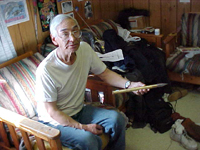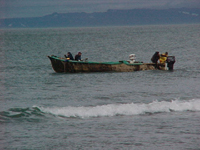Raymond Seetook
"The Sea and the land is our garden."
Raymond Seetook was born in Wales, Alaska fifty-six years ago. He has lived in Wales his entire life. His father was born in Wales and his mother was from the Siberian side across the Bering Strait. The Bering Strait is fifty-five miles from the coast of Alaska.
There are approximately 150-170 people (Inupiaq) in the village of Wales. The term Inuit means "the people". The term Inupiaq means the "real people". The
village of Wales was originally called Kingegan.
Raymond spoke of his people having many names. They sometimes took the name of their mother's name as well as their father. They had an Eskimo name and an
English name. Some of his names were Suito and Ishakome. He was also related to Joseph Senungetuk.
Joseph Senungetuk is an artist and a professor. He lives in
Nome today. He worked with another artist, David Barr to create an art piece that stands above Wales overlooking the Bering Sea. It is a dog sled with a
dove. The dog sled stands for the way they traveled, and the dove stands for peace among countries. It is pointed across the sea towards Russia. In addition,
there is one on the Siberian side pointing to Alaska. The whole village celebrated this when it was finished in the early 1980's. The people also celebrate on many
other occasions. They celebrate holidays such as Christmas, Thanksgiving, and the 4th of July. They also celebrate their heritage with
native dances. These dances were forbidden for many years because of the missionary work done in Wales. They have started with the dance festival again. There
is a big celebration when a whale is caught. The entire village takes part.
In 1918, there was a terrible influenza epidemic. Wales or Kingegan lost many people. Many have also died from tuberculosis. Both of his parents died from the flu. There are many
Inupiaq villages along the coast of Alaska. One of them Shishmaref had no causalities. Why? For some reason, they did not let anyone into their village.
And no one could leave and come back. As a result, they were spared.
The Inupiaq people have lived a subsistence way of life for hundreds of years. They hunt for their food. They hunt walrus, seal, moose, caribou, reindeer, and
musk oxen. They fish for salmon. And they hunt for whales. The hunt for whales is very important to their life. They will hunt beluga and gray whales, but their
favorite is the bowhead. Raymond Seetook learned this way of life from his
father. His father learned it from his father. He has taught his sons this way of life. This is the way of the Inupiaq.
Hunting: Raymond learned to hunt when he was a young boy. It was a very important event to "get your first seal". It was equally important when you hunted your
first walrus. But the most important was the hunting of the bowhead whale.
Raymond has been involved with the successful hunting
of the last two whales. A whale was traditionally hunted from an umiak or skin
boat. A wooden frame is built and then 3-4 walrus skins are stretched over the frame. They were very strong boats and could actually fit up to 30 people in
them. They are usually 20-30 feet in length. A whaling crew was usually less than ten men. If they needed more men, other boats would join them to help.
Today, they use modern boats. Hunting a whale is a very difficult endeavor. A
bowhead whale can be 60 feet long. A whale weighs one ton per foot. His catch was 57 feet. After they capture the whale they cut the flukes off and tow it
in. His whale took around ten hours to bring it in. When he caught his first whale, he let his father have the first cut. They cut the meat called muktuk. The
first taste of muktuk is a great honor. Raymond said he loves Eskimo food, especially muktuk. A whale is hunted with a dart gun or harpoon gun and
is shot by the striker. Each man has a job to do. It is a total team effort. The dart is short and is filled with black powder. It explodes when it hits the whale. Remember, this is their way of life and has been for thousands of years. Raymond said that the bowhead is a very fast but gentle whale. The gray whale is very aggressive. Someone died this past summer hunting a gray whale. Way of life in Wales: the people today, live a modern
life; yet hold on to many traditions and lifestyles of the past. Food is flown in but is very expensive. The people also need to get a license to hunt many of the animals they have hunted for generations. The U.S. government said the bowhead whale was endangered a few years ago and did not want any hunted. It was not the Inupiaq people that decimated the whales. Back in the 1700 and 1800's the Yankee whaling trade killed off many of the whales around the world. They first hunted in the Atlantic Ocean. When they caught most of the whales there, they came to the Arctic region. In the 20th century, many other countries have hunted a tremendous amount of whales. And what happens? The government tells the Inupiaq they must not hunt. When a governmental research project was going to determine the number of whales, it was the Inupiaq who knew the
numbers. Raymond, as well as many other people who live a subsistence lifestyle is angry today. The government sends in expensive food and tells them they cannot
hunt, or only hunt so many. The sea is their garden. Raymond says his people must continue to live from the sea. They take from the sea, and appreciate and give thanks.

This is a cache and the Dome in the background.

This is the Bering Strait at 3 A.M. Raymond said "The Sea is our garden."

Raymond showed us the harpoon used today in whale hunting.

He has also hunted land animals. Pictured are a polar bear head and a musk oxen head.

Raymond's brother also lives in Wales. He was a member of the whaling crew.

Raymond was the last person in the village to catch a whale.

Here is an umiak or skin boat, which is the traditional boat for whaling.

Here is a digital of a photo of the whaling crew that Raymond led when he caught this bowhead whale.
|
